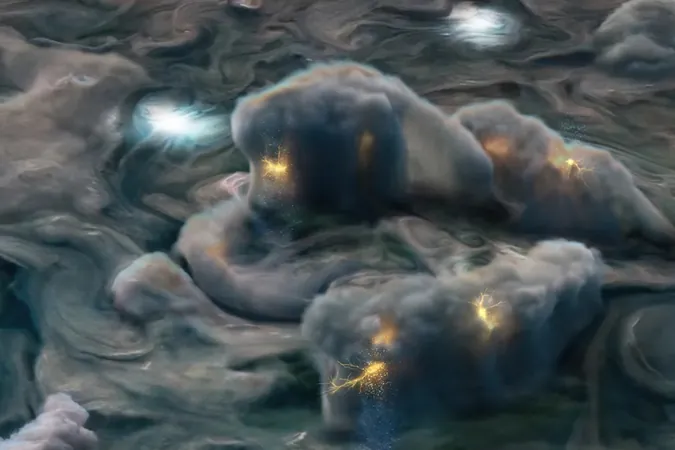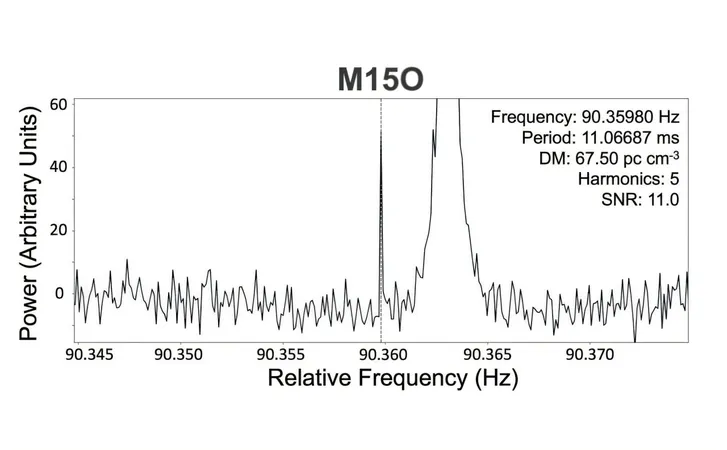
Shocking Discovery: Jupiter's Weather Includes 'Mushballs'!
2025-04-17
Author: Michael
Jupiter's Wild Weather Forecast
Get ready for some jaw-dropping news about the weather on Jupiter! A new study reveals that the gas giant’s atmosphere is not only cloudy but also has a chance of bizarre 'mushballs'—a strange combination of slushy ammonia and water droplets encased in hard ice that tumble down like hail on Earth.
A Surprising Scientific Turnaround
Researchers at the University of California, Berkeley initially set out to debunk the existence of these 'mushballs,' but ended up proving their fascinating reality instead. Planetary scientist Chris Moeckel expressed disbelief at their findings, stating, "For three years, I tried to prove this wrong, but I couldn't." The surprising results suggest that mushball hailstorms could be common not just on Jupiter, but also on Saturn, Uranus, and Neptune.
Understanding Jupiter's Unusual Atmosphere
Unlike the nitrogen and oxygen we breathe on Earth, Jupiter's atmosphere is primarily hydrogen and helium, with trace amounts of ammonia and water. But how does rain form in such a vast gas giant? According to Moeckel, the absence of a solid surface means that raindrops could fall indefinitely, leading to unique atmospheric processes.
The Mechanics of Mushball Formation
The mushballs were theorized to explain Jupiter's poorly mixed upper atmosphere, a concept first proposed in 2020. These mysterious balls form when strong updrafts in Jupiter's storms lift tiny ice particles high into the clouds, mixing them with ammonia vapor. This combination acts like antifreeze, creating a slushy substance that grows until it becomes too heavy to stay aloft, plummeting down into the atmosphere.
Revealing Jupiter’s Hidden Depths
Moeckel and de Pater highlighted that these mushballs require specific climatic conditions to form, including updrafts reaching speeds of 224 miles per hour. Their observations, aided by NASA's Juno spacecraft, revealed the intriguing inner workings of Jupiter’s atmosphere, including hurricane-like vortices and ammonia-rich plumes.
Final Thoughts and Future Research
The study not only revolutionizes our understanding of Jupiter’s weather but also sheds light on the mixing processes that shape its atmosphere. As Moeckel concluded, these findings highlight an unexpected complexity in the atmosphere of our solar system's largest planet—one that challenges previous assumptions and opens new avenues for exploration.
What's Next for Jupiter Research?
The team has also presented groundbreaking 3D visualizations of Jupiter's atmosphere, revealing the depths from which some weather systems originate. The mystery of the mushballs was ultimately confirmed by distinctive signals detected by Juno, leaving researchers eager to uncover more about the wonders of Jupiter's climate.









 Brasil (PT)
Brasil (PT)
 Canada (EN)
Canada (EN)
 Chile (ES)
Chile (ES)
 Česko (CS)
Česko (CS)
 대한민국 (KO)
대한민국 (KO)
 España (ES)
España (ES)
 France (FR)
France (FR)
 Hong Kong (EN)
Hong Kong (EN)
 Italia (IT)
Italia (IT)
 日本 (JA)
日本 (JA)
 Magyarország (HU)
Magyarország (HU)
 Norge (NO)
Norge (NO)
 Polska (PL)
Polska (PL)
 Schweiz (DE)
Schweiz (DE)
 Singapore (EN)
Singapore (EN)
 Sverige (SV)
Sverige (SV)
 Suomi (FI)
Suomi (FI)
 Türkiye (TR)
Türkiye (TR)
 الإمارات العربية المتحدة (AR)
الإمارات العربية المتحدة (AR)